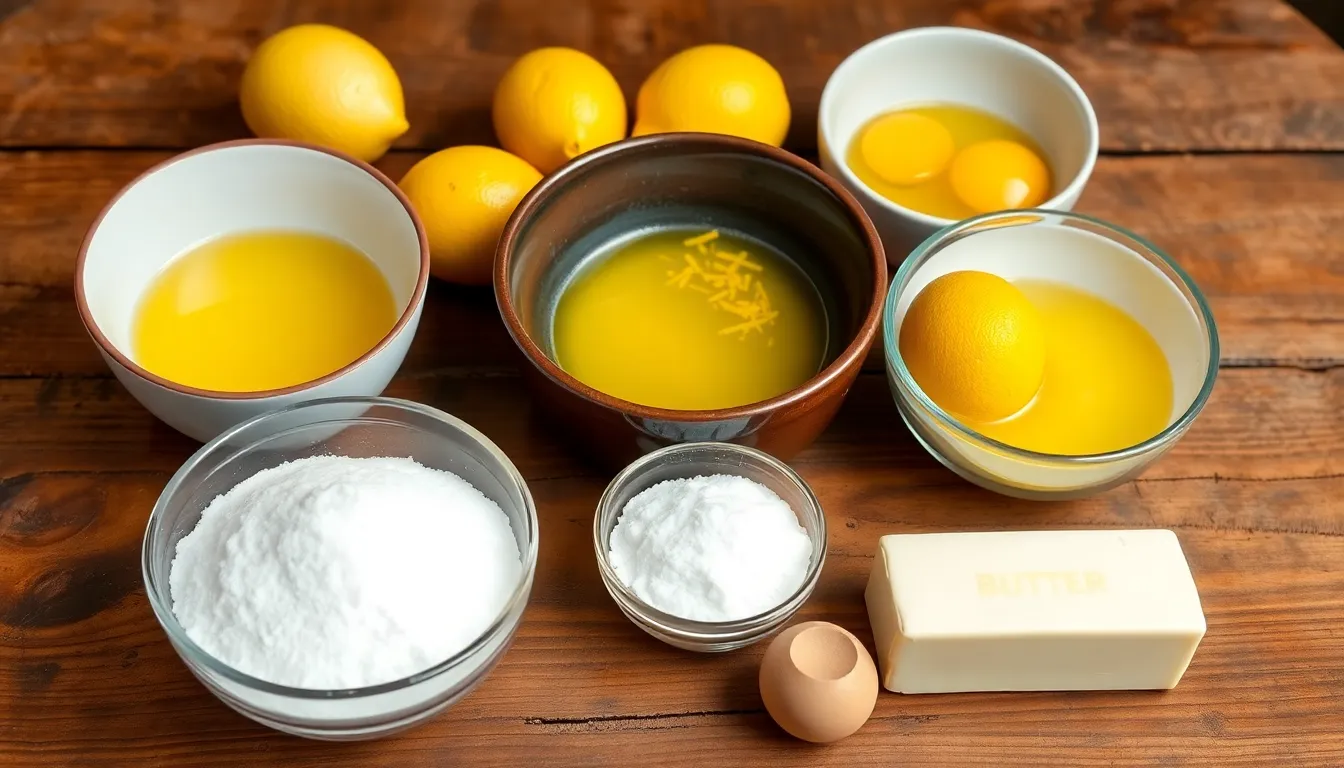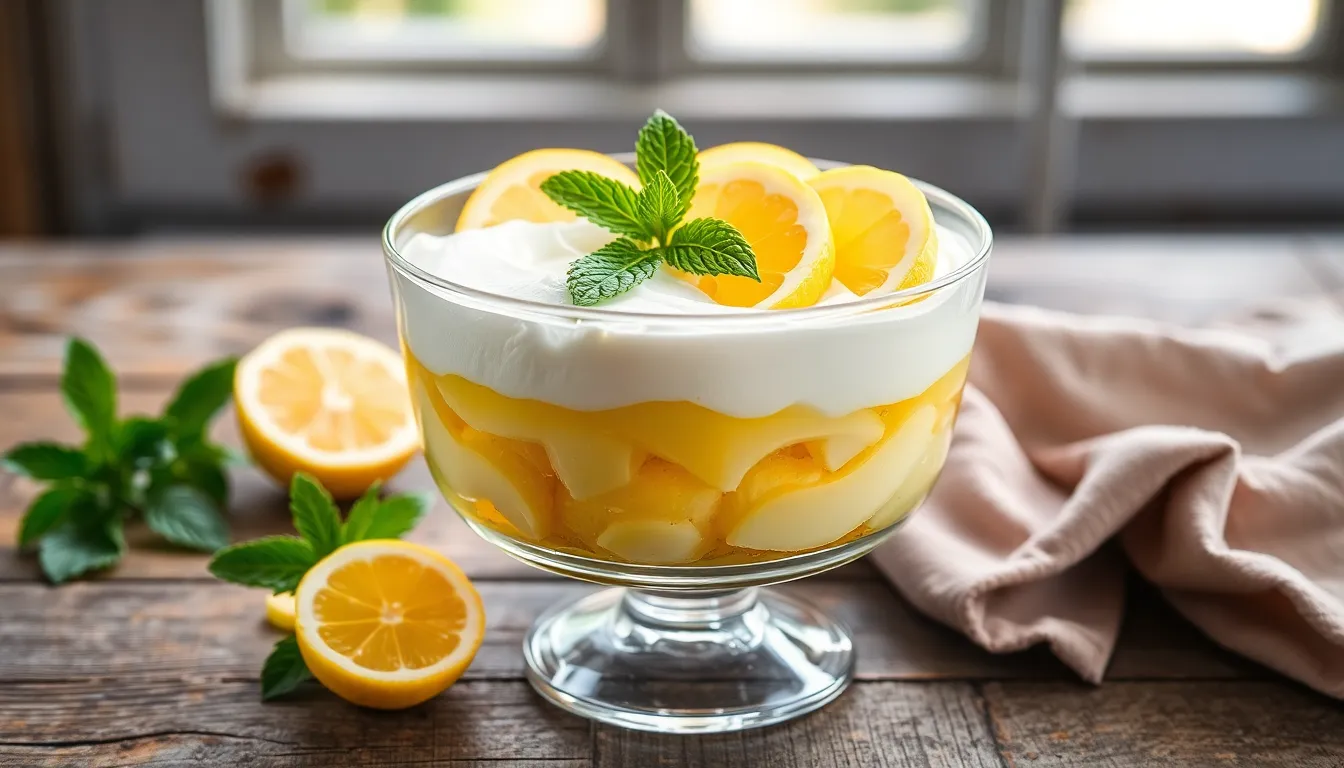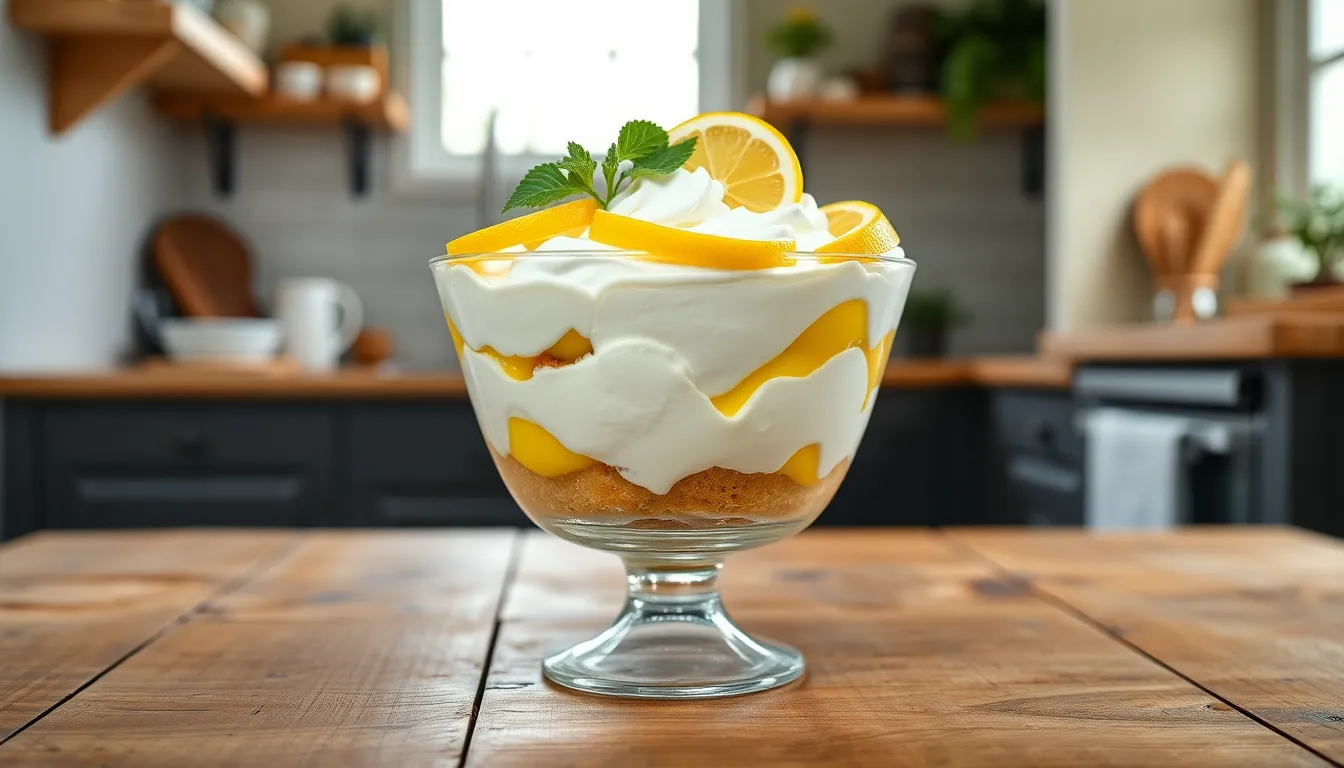Equipment Needed
Creating this show-stopping lemon trifle requires exact tools that ensure each layer develops perfectly. Your success depends on having the right equipment to achieve those stunning visual layers and optimal textures.
Essential Mixing Equipment:
- Large glass trifle bowl (2-3 quart capacity)
- Electric hand mixer or stand mixer
- Large mixing bowls (at least 3 bowls)
- Medium-sized saucepan for lemon curd
- Wire whisk for smooth custard preparation
Measuring and Prep Tools:
- Digital kitchen scale for precise measurements
- Liquid and dry measuring cups
- Measuring spoons set
- Citrus zester or microplane grater
- Sharp paring knife for lemon preparation
Specialty Items:
- Fine-mesh strainer for silky lemon curd
- Rubber spatula for gentle folding
- Piping bag with decorative tip (optional)
- Individual glass dessert bowls (if making single servings)
Your trifle bowl should be transparent to showcase those beautiful golden layers of lemon curd and fluffy cake. A glass bowl with straight or slightly curved sides works best for even layering. The bowl’s wide opening allows easy assembly while its depth accommodates multiple generous layers.
Temperature control becomes crucial when preparing the lemon curd and custard components. A heavy-bottomed saucepan distributes heat evenly and prevents scorching. Your electric mixer saves time and effort when whipping cream to perfect peaks and ensures your custard reaches the ideal consistency.
Ingredients

These carefully selected ingredients work together to create the perfect balance of citrus brightness and creamy indulgence. Each component plays a crucial role in building the layers of flavor and texture that make this lemon trifle unforgettable.
For the Lemon Curd
- 6 large egg yolks
- 1/2 cup granulated sugar
- 1/3 cup fresh lemon juice (from 2-3 lemons)
- 2 tablespoons lemon zest (from 2 lemons)
- 6 tablespoons unsalted butter, cold and cubed
- 1/4 teaspoon salt
For the Sponge Cake
- 4 large eggs, room temperature
- 2/3 cup granulated sugar
- 1 cup all-purpose flour, sifted
- 1/4 cup unsalted butter, melted and slightly cooled
- 1 teaspoon vanilla extract
- 1/4 teaspoon salt
- 3 tablespoons whole milk
For the Whipped Cream
- 2 cups heavy cream, chilled
- 1/4 cup powdered sugar
- 1 teaspoon vanilla extract
- 1 tablespoon lemon zest (from 1 lemon)
For Assembly
- 1/4 cup lemon juice for brushing cake
- 2 tablespoons powdered sugar for dusting
- Fresh lemon slices for garnish
- Additional lemon zest for topping
- Fresh mint leaves (optional)
Instructions

Transform your kitchen into a dessert haven with these step-by-step instructions that guide you through creating each component of this stunning lemon trifle. Follow these detailed steps to achieve the perfect balance of flavors and textures.
Make the Lemon Curd
Begin by whisking the 6 large egg yolks with ¾ cup granulated sugar in a medium saucepan until the mixture becomes pale and thick. Add ½ cup fresh lemon juice and 2 tablespoons lemon zest to the egg mixture. Place the saucepan over medium-low heat and stir constantly with a wooden spoon for 8-10 minutes until the curd coats the back of the spoon.
Remove the pan from heat and immediately whisk in 6 tablespoons cold unsalted butter one piece at a time until fully incorporated. Strain the curd through a fine-mesh strainer into a clean bowl to remove any lumps. Add ¼ teaspoon salt and stir gently. Press plastic wrap directly onto the surface of the curd to prevent a skin from forming and refrigerate for at least 2 hours.
Prepare the Sponge Cake
Preheat your oven to 350°F and grease a 9-inch round cake pan with butter and flour. Beat 4 large eggs with ½ cup granulated sugar using an electric mixer on high speed for 5-6 minutes until the mixture triples in volume and becomes pale yellow.
Sift 1 cup all-purpose flour with ½ teaspoon salt in a separate bowl. Gently fold the flour mixture into the egg mixture in three additions using a rubber spatula. Combine 3 tablespoons melted butter with 2 tablespoons whole milk and 1 teaspoon vanilla extract in a small bowl. Fold this mixture into the batter until just combined.
Pour the batter into the prepared pan and bake for 25-30 minutes until the cake springs back when lightly touched. Cool completely in the pan for 10 minutes before turning out onto a wire rack. Cut the cooled cake into 1-inch cubes once completely cooled.
Whip the Cream
Chill your mixing bowl and beaters in the refrigerator for 15 minutes before beginning. Pour 2 cups heavy cream into the chilled bowl and beat on medium speed until soft peaks form. Gradually add ¼ cup powdered sugar and continue beating until medium peaks form.
Add 1 teaspoon vanilla extract and 1 tablespoon lemon zest to the cream mixture. Beat for another 30 seconds until the peaks hold their shape but remain smooth and spreadable. Avoid overbeating to prevent the cream from becoming grainy.
Assemble the Trifle
Brush the sponge cake cubes lightly with 2 tablespoons lemon juice using a pastry brush. Place one-third of the cake cubes in the bottom of your glass trifle bowl. Spoon half of the lemon curd over the cake layer and spread gently with an offset spatula.
Add half of the whipped cream over the lemon curd layer and smooth the surface. Repeat with another layer of cake cubes brushed with lemon juice followed by the remaining lemon curd. Top with the final layer of cake cubes and finish with the remaining whipped cream.
Dust the top with powdered sugar using a fine-mesh sieve. Garnish with fresh lemon slices and mint leaves if desired. Refrigerate the assembled trifle for at least 4 hours or overnight to allow the flavors to meld and the layers to set properly.
Make-Ahead Instructions

You can prepare this lemon trifle up to 24 hours before serving for the best flavor development. Start by making the lemon curd up to 3 days in advance and storing it covered in the refrigerator. The tangy curd actually improves as it sits allowing the flavors to meld beautifully.
Bake your sponge cake 1-2 days ahead and wrap it tightly in plastic wrap once completely cooled. Store the wrapped cake at room temperature to maintain its tender crumb. This advance preparation makes assembly day much more manageable.
Whip your cream on the day of assembly for optimal texture and stability. Fresh whipped cream holds its peaks better and provides the silky consistency that makes each bite perfect. Prepare the cream just before you plan to layer the trifle.
Assemble your complete trifle 4-6 hours before serving to allow proper setting time. The layers need time to meld together while maintaining their distinct textures. Refrigerate the assembled dessert uncovered for the first hour then cover with plastic wrap.
Store your finished trifle in the refrigerator for up to 2 days after assembly. The flavors continue to develop during storage creating an even more delicious dessert. Keep the trifle covered to prevent it from absorbing other refrigerator odors.
Add fresh garnishes like lemon slices and mint leaves just before serving for the most vibrant presentation. These final touches provide color contrast and aromatic appeal that guests notice immediately. Remove the trifle from the refrigerator 15 minutes before serving to bring it to the ideal temperature.
Storage Tips

Your lemon trifle maintains its delicious quality when stored properly in the refrigerator. Cover the trifle bowl tightly with plastic wrap or transfer individual portions to airtight containers before refrigerating. The assembled dessert stays fresh for up to 48 hours while the flavors continue to develop and meld together.
Store leftover components separately if you prefer maximum freshness for future assembly. Place any remaining lemon curd in an airtight container where it keeps for up to one week in the refrigerator. Leftover sponge cake should be wrapped tightly in plastic wrap and stored at room temperature for 2-3 days or frozen for up to one month.
Whipped cream loses its texture quickly so avoid storing it for extended periods. Fresh whipped cream maintains its peak consistency for only 24 hours when refrigerated in a covered container. Rewhip gently by hand if the cream appears slightly deflated before serving.
Individual serving portions offer convenient storage options for busy schedules. Spoon the trifle into mason jars or glass containers with tight-fitting lids for grab-and-go desserts. These individual portions maintain their layered appearance and stay fresh for the same 48-hour timeframe.
Freezing the complete trifle is not recommended as the cream and custard textures become grainy when thawed. But you can freeze the sponge cake components separately for future trifle making. Wrap cake layers individually in plastic wrap then aluminum foil before freezing for optimal protection against freezer burn.
Remove your trifle from the refrigerator 15-20 minutes before serving to allow the flavors to brighten and the textures to soften slightly. This brief warming period enhances the overall eating experience without compromising food safety.
Serving Suggestions

Transform your lemon trifle presentation with elegant serving techniques that showcase each vibrant layer. Present the dessert directly from your glass trifle bowl for maximum visual impact at dinner parties or special occasions.
Individual portions work beautifully for formal dining experiences. Scoop generous servings into stemmed glasses or dessert bowls to highlight the distinct layers of sponge cake, lemon curd, and whipped cream. This approach allows your guests to appreciate the careful construction of each component.
Enhance the dessert’s appeal with thoughtful garnish combinations. Fresh lemon wheels arranged around the serving edge add brightness and reinforce the citrus theme. Sprinkle lightly toasted coconut flakes over the whipped cream for textural contrast and tropical notes.
Consider seasonal presentation variations to match your dining occasion. Spring gatherings benefit from edible flower petals like violas or pansies scattered across the top layer. Summer events call for fresh berry medleys that complement the tart lemon flavors beautifully.
Serve alongside complementary beverages that enhance the trifle’s citrus profile. Sparkling wine or champagne cuts through the rich cream while highlighting the bright lemon notes. Earl Grey tea provides a sophisticated pairing that balances the dessert’s sweetness with aromatic bergamot undertones.
Temperature timing plays a crucial role in optimal serving conditions. Remove your trifle from refrigeration 15-20 minutes before guests arrive to allow flavors to develop fully. This brief warming period ensures the cream achieves the perfect consistency while the sponge cake maintains its tender texture.
Portion control becomes effortless with proper serving tools. Use a large spoon to reach through all layers, ensuring each serving contains balanced amounts of cake, curd, and cream. Clean your serving utensil between portions to maintain the trifle’s pristine appearance throughout your event.
Conclusion
You’ve now mastered creating a stunning lemon trifle that’s guaranteed to become your go-to dessert for special occasions. This recipe combines traditional techniques with fresh citrus flavors to deliver a dessert that’s both impressive and achievable.
Your guests will be amazed by the beautiful layers and the perfect balance of textures and flavors. The best part? You can prepare most components ahead of time making entertaining stress-free.
Whether you’re hosting a dinner party or celebrating a special milestone this lemon trifle will steal the show. With proper storage techniques and creative serving suggestions you’ll have endless opportunities to showcase this delightful dessert.
Start gathering your ingredients and equipment – your next memorable dessert experience awaits!

